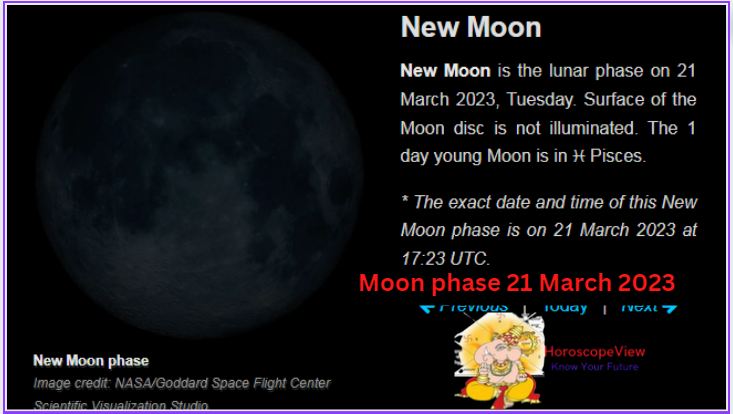What is the Moon phase for today 21 March 2023? The current moon phase for 21st March, 2023 is the New Moon phase. In this article, you will find more information about today’s moon phase 21 March 2023 such as illumination, the approximate distance from the Earth to the moon, and what is the moon sign and more.
On this day, the moon is -0.37 days old and 0.31% illuminated with a tilt of -334.383°. The approximate distance from Earth to the moon is 364,744.97 km and the moon sign is Pisces.
Moon Phase 21 March 2023
Let’ see What is the Moon Phase 21 March 2023?
Moon Phase for Monday 21 Mar 2023
The Moon phase for 21st March 2023 is the New Moon phase. In this moon phase, the moon is clearly positioned between the Sun and Earth and is 0% illuminated (i.e the moon is really not visible to us in the sky).
Moon Phase Details for Mar 21st, 2023
- Phase: New Moon
- Moon age: -0.37 days
- Moon illumination: 0.31%
- Moon tilt: -334.383°
- Moon angle: 0.55
- Moon distance: 364,744.97 km
- Moon sign: Pisces
-
Get Your Soulmate Drawing (Exact Image)
Many People Are Shocked To See What Their Soulmate Actually Looks Like.
Due to the alignment of the Sun, the Moon and Earth as well, the side of the moon that faces Earth is left in complete darkness. In technical terms of moon research, this is refer to as a conjunction or Syzygy.
Also, during the New Moon phase, the moon rises and sets at around the same time how the performance of the Sun. This clearly brings to the moon too close to the glare of the Sun for us to see the moon with the naked eye.
Today, 21 March 2023, the Moon will be in a New Moon phase. During this phase the Moon is really very close to the sun in the sky to be visible. The moon rises and sets with the sun and is not present in the night sky at all. Because of this the night sky is darker and an excellent and perfect time to view other celestial objects.
Like the Full Moon, a New Moon that happens at a very specific time when the sun and moon have the same ecliptic longitude and it can be measured down to the second it occurs.
Related:
For more information on the Moon-Cycle and on each moon phase check-out Wikipedia Lunar Phase page.
Thanks for reading and sharing this guide.



Leave a Reply